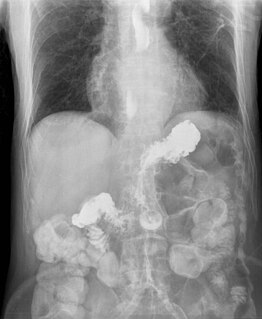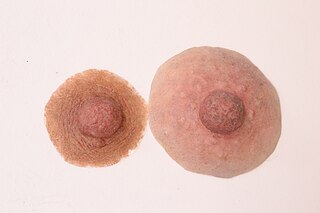
In medicine, a prosthesis or prosthetic implant is an artificial device that replaces a missing body part, which may be lost through trauma, disease, or a condition present at birth. Prostheses are intended to restore the normal functions of the missing body part. Amputee rehabilitation is primarily coordinated by a physiatrist as part of an inter-disciplinary team consisting of physiatrists, prosthetists, nurses, physical therapists, and occupational therapists. Prostheses can be created by hand or with computer-aided design (CAD), a software interface that helps creators design and analyze the creation with computer-generated 2-D and 3-D graphics as well as analysis and optimization tools.

Gastroesophageal reflux disease (GERD), is a chronic condition in which stomach contents rise up into the esophagus, resulting in either symptoms or complications. Symptoms include the taste of acid in the back of the mouth, heartburn, bad breath, chest pain, regurgitation, breathing problems, and wearing away of the teeth. Complications include esophagitis, esophageal stricture, and Barrett's esophagus.

Breast augmentation and augmentation mammoplasty is a cosmetic surgery technique using breast-implants and fat-graft mammoplasty techniques to increase the size, change the shape, and alter the texture of the breasts of a woman. Augmentation mammoplasty is applied to correct congenital defects of the breasts and the chest wall. As an elective cosmetic surgery, primary augmentation changes the aesthetics – of size, shape, and texture – of healthy breasts.
Esophageal speech, also known as esophageal voice, is an airstream mechanism for speech that involves oscillation of the esophagus. This contrasts with traditional laryngeal speech, which involves oscillation of the vocal folds. In esophageal speech, pressurized air is injected into the upper esophagus and then released in a controlled manner to create the airstream necessary for speech. Esophageal speech is a learned skill that requires speech training and much practice. On average it takes 6 months to a year to learn this form of speech. Because of the high level of difficulty in learning esophageal speech, some patients are unable to master the skill.

Laryngectomy is the removal of the larynx and separation of the airway from the mouth, nose and esophagus. In a total laryngectomy, the entire larynx is removed. In a partial laryngectomy, only a portion of the larynx is removed. Following the procedure, the person breathes through an opening in the neck known as a stoma. This procedure is usually performed by an ENT surgeon in cases of laryngeal cancer. Many cases of laryngeal cancer are treated with more conservative methods. A laryngectomy is performed when these treatments fail to conserve the larynx or when the cancer has progressed such that normal functioning would be prevented. Laryngectomies are also performed on individuals with other types of head and neck cancer. Post-laryngectomy rehabilitation includes voice restoration, oral feeding and more recently, smell and taste rehabilitation. An individual's quality of life can be affected post-surgery.
Osseointegration is the direct structural and functional connection between living bone and the surface of a load-bearing artificial implant. A more recent definition defines osseointegration as "functional ankylosis ", where new bone is laid down directly on the implant surface and the implant exhibits mechanical stability. Osseointegration has enhanced the science of medical bone and joint replacement techniques as well as dental implants and improving prosthetics for amputees.

An implant is a medical device manufactured to replace a missing biological structure, support a damaged biological structure, or enhance an existing biological structure. Medical implants are man-made devices, in contrast to a transplant, which is a transplanted biomedical tissue. The surface of implants that contact the body might be made of a biomedical material such as titanium, silicone, or apatite depending on what is the most functional. In some cases implants contain electronics, e.g. artificial pacemaker and cochlear implants. Some implants are bioactive, such as subcutaneous drug delivery devices in the form of implantable pills or drug-eluting stents.

An artificial heart valve is a one-way valve implanted into a person's heart to replace a valve that is not functioning properly. Artificial heart valves can be separated into three broad classes: mechanical heart valves, bioprosthetic tissue valves and engineered tissue valves.
An electrolarynx, sometimes referred to as a "throat back", is a medical device about the size of a small electric razor used to produce clearer speech by those people who have lost their voice box, usually due to cancer of the larynx. The most common device is a handheld, battery-operated device pressed against the skin under the mandible which produces vibrations to allow speech; other variations include a device similar to the "talk box" electronic music device, which delivers the basis of the speech sound via a tube placed in the mouth. Earlier non-electric devices were called mechanical larynxes. Along with developing esophageal voice, using a speech synthesizer, or undergoing a surgical procedure, the electrolarynx serves as a mode of speech recovery for laryngectomy patients.

A breast implant is a prosthesis used to change the size, shape, and contour of a person's breast. In reconstructive plastic surgery, breast implants can be placed to restore a natural looking breast following a mastectomy, to correct congenital defects and deformities of the chest wall or, cosmetically, to enlarge the appearance of the breast through breast augmentation surgery.

A penile implant is an implanted device intended for the treatment of Erectile dysfunction, Peyronie's disease, ischemic Priapism, deformity and any traumatic injury of the penis, and for phalloplasty in men or phalloplasty and metoidioplasty in female-to-male gender reassignment surgery. Men also opt for penile implants for aesthetic purposes. Men’s satisfaction and sexual function is influenced by discomfort over genital size which leads to seek surgical and non-surgical solutions for penis alteration. Although there are many distinct types of implants, most fall into one of two categories: malleable and inflatable transplants.
A tracheo-esophageal puncture is a surgically created hole between the trachea (windpipe) and the esophagus in a person who has had a total laryngectomy, a surgery where the larynx is removed. The purpose of the puncture is to restore a person’s ability to speak after the vocal cords have been removed. This involves creation of a fistula between trachea and oesophagus, puncturing the short segment of tissue or “common wall” that typically separates these two structures. A voice prosthesis is inserted into this puncture. The prosthesis keeps food out of the trachea but lets air into the esophagus for oesophageal speech.

Nose prosthesis is a craniofacial prosthesis for someone who no longer has their original nose. Nose prostheses are designed by anaplastologists who have their patients referred to them by ear, nose, and throat doctors and plastic surgeons. Unlike the more common nasal operation called a rhinoplasty, total reconstruction of the nose using existing tissue, prosthetic nose implantation requires the nose to be made completely from synthetic material; prior to getting a nose prosthesis, the original nose is usually left partially intact, so a rhinectomy, surgical removal of the nose, has to be performed before a prosthetic nose can be used. One of the biggest challenges for anaplastologists in constructing a nose prosthesis is finding the right material to use for the nose, as it's a complex organ with several distinct functions and a unique structure. The major functions of the nose include the sense of smell (olfaction), filtered breathing, and alteration of speech. All of these tasks can be completed due to the nose’s network of bones, cartilage, and muscle, which also helps to keep the nose stable on the face. Although there are currently usable prosthetic noses, they only have temporary functionality. Advancements in areas such as 3D-printing have medical professionals hoping to create noses that are as efficient as the real ones.
Eric M. Genden, MD, MHCA, FACS is a United States head and neck cancer surgeon at the Icahn School of Medicine at Mount Sinai and Mount Sinai Health System in New York City. where he serves as the Isidore Friesner Professor and Chairman of Otolaryngology–Head and Neck Surgery and Professor of Neurosurgery and Immunology. According to his biography at Mount Sinai, Genden's professional titles also include Senior Associate Dean for Clinical Affairs, He is Executive Vice President of Ambulatory Surgery, and Director of the Head and Neck Institute at the Mount Sinai Health System.
Roentgen stereophotogrammetry (RSA) is a highly accurate technique for the assessment of three-dimensional migration and micromotion of a joint replacement prosthesis relative to the bone it is attached to. It was introduced in 1974 by Göran Selvik.

Voice therapy consists of techniques and procedures that target vocal parameters, such as vocal fold closure, pitch, volume, and quality. This therapy is provided by speech-language pathologists and is primarily used to aid in the management of voice disorders, or for altering the overall quality of voice, as in the case of transgender voice therapy. Vocal pedagogy is a related field to alter voice for the purpose of singing. Voice therapy may also serve to teach preventive measures such as vocal hygiene and other safe speaking or singing practices.

Heat and Moisture Exchangers (HME) are devices used in mechanically ventilated patients intended to help prevent complications due to "drying of the respiratory mucosa, such as mucus plugging and endotracheal tube (ETT) occlusion." HMEs are one type of commercial humidification system, which also include non-heated-wire humidifiers and heated-wire humidifiers.

Heat and moisture exchangers (HME) are used after laryngectomy to help reduce breathing restrictions and compensate nasal functions.

Nipple/Areola prostheses are made of silicone by breast prosthesis manufacturers and anaplastologists for breast cancer survivors who were treated for breast cancer with a mastectomy. Prostheses can be worn weeks after a mastectomy, breast reconstruction, or even nipple reconstruction. As an inexpensive and convenient alternative to surgery, patients may choose to wear them anytime during treatment. Patients who ultimately find nipple prostheses thought that they should be informed of them during the consultation prior to mastectomy.

Claude-Henri Chouard is a French surgeon born on 3 July 1931 in the 15th arrondissement of Paris, this Otologist has been a full member of the Académie Nationale de Médecine since 1999. He was director of the AP-HP Laboratory of Auditory Prosthesis and director of the ENT Research Laboratory at Paris-Saint-Antoine University Hospital from 1967 to 2001. He was also head of the institution's ENT Department from 1978 to 1998. In 1982, he was elected a member of the International Collegium ORL-AS. He achieved worldwide recognition in the late 1970s thanks to the work completed by his Paris laboratory's multidisciplinary team on the multichannel cochlear implant. This implanted electronic hearing device was developed at Saint-Antoine and alleviates bilateral total deafness. When implanted early in young children, it can also help overcome the spoken language problems associated with deafness.













